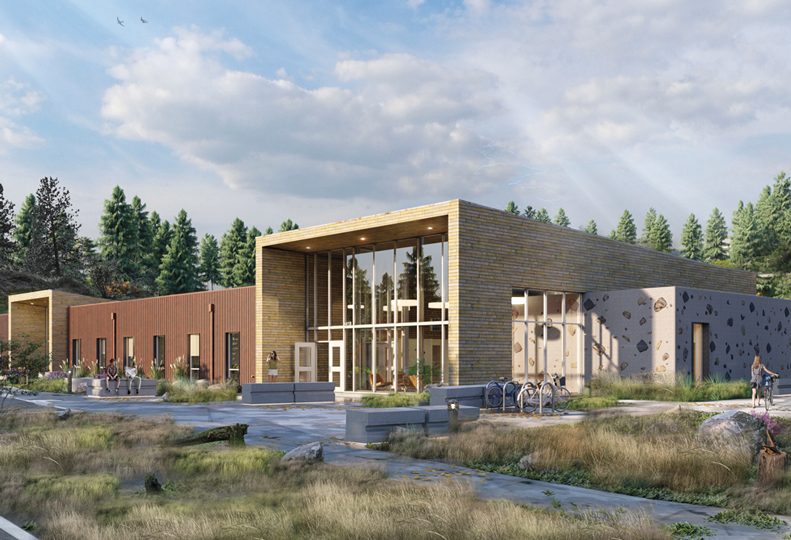
Home » Spokane Conservation District moves forward with new building
Spokane Conservation District moves forward with new building
New conservation campus to be a multiphase project

August 27, 2020
The Spokane Conservation District has broken ground on its planned new facility in Spokane Valley, says Vicki Carter, director of the district.
The project will be a multiphase development, Carter says.
“This is a 10-year project. this is not a today or tomorrow project,” she says. “We’ve got a long way to go.”
The first phase, a 12,350-square-foot building under construction at 4422 E. Eighth, in Spokane Valley, is valued at $4.3 million.
As earlier reported in the Journal, the district purchased the nearly 50-acre site at the southeast corner of Eighth Avenue and Havana Street in May 2017 for $1.3 million from CPM Development Corp.
“It’s been in some sort of a planning and feasibility setting for a couple of years,” Carter says.
Site cleanup and restoration has been ongoing since the purchase.
“We’ll be doing some reshaping of a lot of the steep hillsides and removing some of the asphalt that was left behind,” she says. “We dismantled and removed all of the old industrial equipment that was there.”
The district also has planted over 4,000 trees in its nursery, and those will be put out on the property as it’s redeveloped, Carter adds.
Kilgore Construction Inc., of Colbert, is the general contractor on the project, which was designed by Integrus Architecture PS, of Spokane, and AHBL Inc., also of Spokane.
Numerica Credit Union is the project lender, according to a newsletter posted to the district’s website.
The facility will host several eco-friendly features, Carter says.
Mark Dailey, president of Integrus Architecture, says the building’s design features an east-west axis to make the most of a passive solar approach to heating.
Further, he adds, the building itself will be reminiscent of rural farm structures that dot the Inland Northwest landscape.
Most of the building will be constructed using reclaimed barnwood and naturally weathering steel, he says. Another portion of the building will be erected using tilt-up concrete walls inlaid with stones handpicked from around the former quarry where the building will be situated.
“It’ll have a really rich textural quality,” Dailey says. “If you picked it up and moved it, it wouldn’t fit in. It’s so tied to that location.”
Carter adds, “We’re doing things to maximize our energy efficiency and all the sustainability and environment practices.”
The site and building will be used as a living learning tool with demonstration gardens planted on the site to show indigenous plants, water runoff forming a natural aquifer, and turning an old pond on the site into a natural wetland area, Dailey says.
“We’re using the stuff that’s already there to our advantage,” Dailey explains. “It’s a really humble, hardworking approach to the architecture. It’s really about its program and the learning that the Spokane Conservation District is all about.”
Looking forward, Carter says that additional structures planned on the site include a second partnership building and a regional conference center.
“But those are down the road,” she says. “We’ve got to get one done first.”
The Spokane Conservation District was formed in 1973 to develop and implement programs and projects that protect and conserve natural and renewable resources.
It oversees 11 programs, including the Direct Seed Loan Program, which offers low-interest loans for agricultural equipment purchases that help place seeds and fertilizers in one or two passes and aids in the removal or management of residue, making it easier to switch to no-tillage operations.
The district’s Family Forest Fish Passage Program assists landowners in removing fish barriers on their properties.
The Firewise program offers fire-risk assessments to homeowners.
The Green Zone, an outdoor public learning center, demonstrates water and energy conservation, while the SpokaneScape Program offers credits for removing lawns and replacing them with drought-tolerant plants and mulch.
Other district offerings include the Livestock and Land Program, the Voluntary Stewardship Program, Vets on the Farm, and Watershed Planning.The conservation district is funded through a mix of public and private grants, state appropriations, and property taxes through Spokane County. It currently has 18 employees, according to its website.
The district was formed through the consolidation of the Southwest Spokane, North Spokane, Central Spokane, and Latah-Rock Creek districts.
Partners of the district, the Washington State Conservation Commission and the Upper Columbia Resource and Development Council, will relocate to the new facility when it’s completed, Carter says.
The conservation commission is the coordinating state agency for 45 conservation districts in the state. The resource and development council works to conserve natural resources while driving economic development.
Those two organizations currently occupy space the district’s building at 210 N. Havana, in Spokane.
There are nearly 3,000 conservation districts nationwide.
An existing, two-story, 7,000-square-foot office on the new site is leased by Intrinium Inc., an information technology and security solutions company based in Spokane Valley, Carter adds.
Latest News Up Close Government
Related Articles
Related Products



